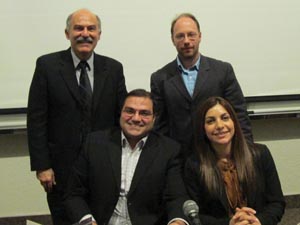Suren Oganessian
Staff Writer

The city of Jerusalem has captured the imagination of followers of three of the world’s major religions: Christianity, Judaism, and Islam, and its has been the focal point of pilgrimages for almost two millennia.
But often overlooked is Jerusalem’s Armenian community, which from the 5th century to the present has contributed much to its history and culture. On Friday, February 8, 2013 the Armenian Studies Program at Fresno State organized a symposium, “Armenian Jerusalem: Past and Present,” with four guests presenting various perspectives on the history of Jerusalem’s Armenian Quarter and of its present condition.
The event was co-sponsored by Save the ArQ, a non-profit organization that aims to create awareness of the significant religious, cultural, and historical presence of Armenians in Jerusalem and to encourage the revitalization of the Armenian Quarter in the Old City.
Dr. Tamar Boyadjian (UCLA), Prof. Barlow Der Mugrdechian (Coordinator of the Armenian Studies Program at Fresno State), Dr. Sergio La Porta (Berberian Professor of Armenian Studies at Fresno State), and Dr. Bedross Der Matossian (University of Nebraska-Lincoln), each spoke on the Armenian connection to the Holy City.
Dr. Boyadjian was the first to speak, on “Lament for the City: Jerusalem in the Medieval Period.” In her lecture, she gave an overview of the role Armenians played in the tumultuous days of the Crusades, when Christian forces from Europe and Islamic forces from the Middle East vied for control of the world’s most Holy City.
When the Pope preached for a crusade to recapture Jerusalem in 1095, the Armenians of Cilicia collaborated with the Christian Europeans, and many Armenians living in Jerusalem, such as the historian Matthew of Edessa, saw the Crusaders as saviors. But with Edessa’s recapture by Muslim forces in 1144, Armenian writers such as Armenian Catholicos Nerses Shnorhali and Grigor Tgha composed well-known lamentations regarding its capture.
With the Third Crusade, Armenian Cilicia under King Levon I once again lent a hand to the Europeans. The period of the Crusades was often chaotic, but Armenians were always at the forefront, and unfortunately, over the centuries many Armenian historical accounts have been dismissed or overlooked.
Prof. Der Mugrdechian’s presentation, on “Armenian Jerusalem Through the Eyes of a Pilgrim” was about his personal spiritual journey to Jerusalem’s Armenian Quarter, giving an overview of the many spiritual landmarks to be found there, such as the Church of the Holy Sepulcher, long a center for Christian pilgrimage.
Der Mugrdechian recalled his first journey to Jerusalem in 1985, and later impressions from his trip with a group of Fresno State students in 1986, some of who were in attendance. Among the photos shown during Der Mugrdechian’s presentation, was an early Armenian mosaic from the St. Polyleucte Church, just outside of the Old City of Jerusalem, which exhibits the earliest known surviving example of Armenian writing. He also showed a photo of a mosaic at the Russian Mt. of Olives Monastery that contained another beautiful Armenian mosaic featuring birds and pomegranates.
Der Mugrdechian’s presentation concluded with slides from the celebration of the 2000th anniversary of Christianity in Jerusalem in January of 2000, attended by Armenia’s then president Robert Kocharian, Palestinian president Yasser Arafat, His Holiness Karekin II, Catholicos of All Armenians and His Beatitude Archbishop Mesrop Mutafian, Armenian Patriarch of Constantinople. In all, Jerusalem is an important part of the global Armenian culture and history, just as Armenians have played an important role in the history of Jerusalem.
Dr. La Porta’s lecture, “Negotiating the Sacred and the Secular: The Armenian Heritage in Jerusalem” focused on the secular aspects of the Armenian Quarter, giving a general overview on what life is like there. Dr. La Porta described the Armenian Quarter as “Saroyan-esque,” in that as a community, it has much in common with Fresno and other Armenian diaspora settlements.
Dr. La Porta first discussed Jerusalem’s repository of Armenian manuscripts in the St. Toros chapel, dating back hundreds of years. The Gulbenkian Library has a large collection of books and periodicals, including a copy of the first printed Armenian book (1512, Venice) and the first printed Armenian Bible (1666, Amsterdam). This makes the Armenian Quarter a boon for academics, as well as for those who come for spiritual reasons.
Also in the Armenian Quarter is the St. Tarkmanchats School, an Armenian school attended by Armenians from Jerusalem and elsewhere in Israel, directed by Father Norayr Kazazian. So aside from being an important pilgrimage destination, Jerusalem is also one of the most important centers of Armenian studies outside of Armenia proper.
Dr. Der Matossian closed the symposium with his presentation entitled “Jerusalem in a Critical Period.” On January 24, 2013, a new Armenian Patriarchate of Jerusalem was elected, to replace the recently deceased Archbishop Torkom Manoogian. Archbishop Nourhan Manougian, the newly elected Patriarch, now faces the challenges of keeping the Armenian Quarter alive.
Der Matossian explained that today many Armenians in the Quarter are technically Jordanian citizens living there with a green card, and thus are unable to own property. Many businesses have moved, and the rent in Jerusalem is higher than most citizens can afford. Of the Armenians still residing in Jerusalem only around a third live in the Armenian Quarter, with many more living outside of the city. What the community lacks today is a unified body to express their grievances to the Israeli government through the Patriarchate.
The event provided a rich view of Jerusalem, past and present.
Save the ArQ is doing its best to voice these concerns and to raise money to help solve these problems, but it will still take the help of the Armenian Diaspora to protect this indispensable epicenter of Armenian history, culture, and spirituality.
 Hye Sharzhoom Armenian Action
Hye Sharzhoom Armenian Action